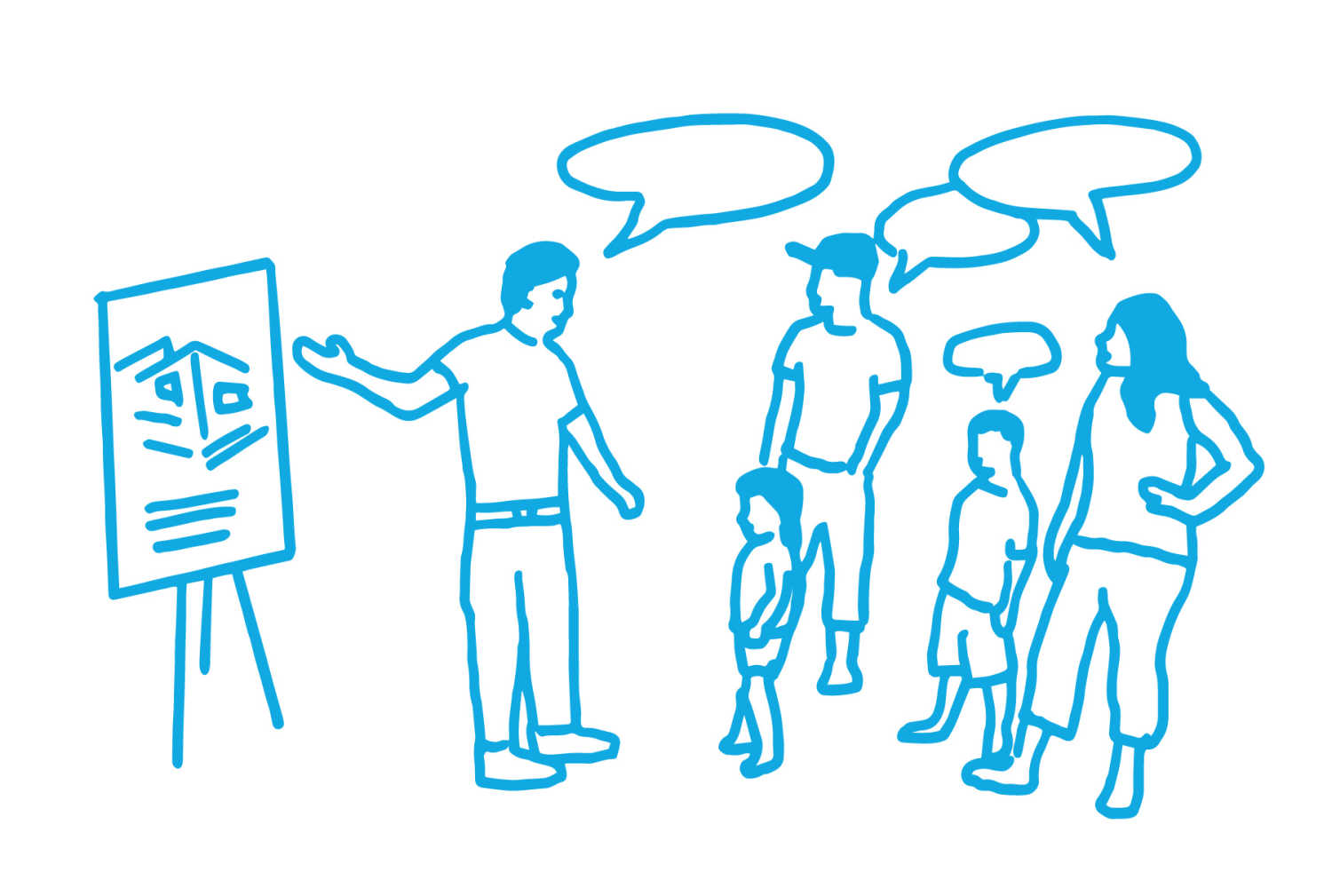Ideas + Insights
January 18, 2024The Equitable Engagement Toolkit: Prioritizing Equity in the Community Design Process

The Neighborhood Design Center has supported the growth of healthy, equitable neighborhoods since its founding in 1968. This year, AmeriCorps Vista Evy DiSalvo created a guide to support NDC staff in carrying out that mission through the Equitable Engagement Toolkit.
What is equitable engagement?
Equitable engagement involves ensuring that community engagement processes are inclusive and support and center the participation of historically marginalized groups, an ideal central to NDC’s mission of addressing historic inequities through community-led design. The Equitable Engagement toolkit provides a reference guide for helping NDC staff prioritize equity throughout the community engagement process.
Throughout history, design and planning have often occurred without prioritizing equitable engagement and centering the voices of those most impacted. Projects such as Baltimore City’s ’Highway to Nowhere” exemplify the enduring repercussions when plans do not include all members of a community as central to a project’s decision-making.
Not only does this practice further perpetuate marginalization and inequity, it often yields projects that fail to adequately serve anyone. The inequity is then further magnified by systemic disinvestment, which amplifies health, economic and other disparities.
A vision for a new resource.
The vision for the toolkit originated as part of a partnership between NDC and the Transform Mid-Atlantic AmeriCorps VISTA program, now entering its third year, and is in collaboration with Morgan State University, the official host institution and project partner.
In the first year, VISTA Jalen Powell-Bartley focused on supporting community engagement in NDC’s planning projects and researching how to improve NDC’s process to make it more equitable.
“We felt that the work of making our processes more equitable is never over and necessitates frequent conversation and reassessment,” says NDC Program Manager Julia DiMauro.

“The goal from the start has been to think about how we might plan, facilitate, and measure equity within our engagement processes, specifically when we take on larger planning projects.”
— Julia DiMauro, NDC Program Manager
Understanding common barriers.
In the VISTA project’s second year, NDC aimed to delve deeper into understanding common barriers to equitable engagement and to strengthen NDC’s engagement methods and practice.
Evy took the lead on the project during its second year at the beginning of her service year last summer. She initially focused on aligning the barriers to engagement with the chronological order of an NDC project so that the team could identify the most challenging stages and where they could use additional resources, guidance, and a means of discussing what success looks like.

Through interviews, staff shared their typical community engagement process and experience and discussed their successes and hurdles. She researched theories about community engagement and challenges within the field and read numerous other toolkits and community engagement resources. Additionally, Evy interviewed NDC community partners and professionals in the community design and engagement sphere at other organizations.
She found plenty of existing internal and external resources. Internally, the NDC Blueprint served as a starting point, and she researched a variety of resources available online regarding equity in engagement and co-design (listed at the end of this article).
Evy discovered two primary challenges staff faced
1. The lack of clearly defined goals for engagement and projects. Without clear goals, it becomes challenging to plan for equity and accessibility.
2. The absence of accessible references and resources, leading to a sense of reinventing the wheel during engagement events or workshops.
By pinpointing the most challenging areas, Evy was able to identify ways to address those challenges to make the process flow more smoothly for NDC staff. She aimed to create a resource to provide guidance for setting strong project goals and clear intentionality while including a collection of tools and methods for engagement practices.
Evy created tools to help staff be intentional about engagement and created a database of methods for reference as they plan engagement events. Using GitBook, a website that allows users to create customized and accessible workbooks, Evy compiled these “tools for engagement” into the Equitable Engagement Toolkit.
No more starting from scratch.
The Equitable Engagement toolkit tries not to reinvent the wheel with regard to how to facilitate more equitable community engagement but rather contextualizes these existing resources within a “typical” NDC process.
The toolkit also includes resources specific to equitable community engagement in Baltimore. By utilizing a resource created specifically for NDC, staff can better understand what types of methods and conversations are necessary at different points throughout a project.
The toolkit focuses on contextualizing and framing a project, which involves setting clear goals and learning more about the community while identifying stakeholders, a crucial aspect of the engagement process.
It provides advice and discussion prompts, as much of the engagement planning occurs during meetings with partners. It also emphasizes the use of data, such as GIS maps of Baltimore, to explore neighborhood design and planning projects. To assist with stakeholder mapping, Evy created templates accessible through a Miro board, which can be copied into project documents for brainstorming during meetings.

Understanding the engagement timeline, aligning engagement with project deliverables, asking the right questions to stakeholders, and planning outreach and engagement activities are also included in the toolkit. Visualizing these details helps externalize the planning process, making it more approachable and manageable.
The toolkit discusses various engagement methods for workshops or similar events and emphasizes the importance of incorporating exciting activities alongside question-and-answer sessions. Each method includes instructions, benefits, and considerations and is categorized based on suitability for different scenarios, audiences, and capacities.
Finally, the Equitable Engagement toolkit also addresses the analysis of engagement results, highlighting the importance of transforming collected notes and ideas into shareable information for designers and the community.

“Instead of creating a plan for engagement from scratch for each project, having a resource that provides the necessary questions and steps will make it much easier to start the process.”
— Evelyn “Evy” DiSalvo, AmeriCorps Vista
“I believe the biggest benefit for NDC will be having an externalized engagement process and planning resource,” says Evy.
In addition to having the finalized toolkit and resources, Julia points to the process of developing the toolkit as part of its success. “There’s been so much conversation internally that’s just been exciting,” says Julia. “Informally, amongst staff, we’re talking about how we can improve what we do, reach more people when we’re doing engagement, and have more honest conversations with community partners about what engagement should look like in order to be equitable and reach audiences that they would like to reach. It resulted in many great conversations with staff about the barriers to engagement and what we might do to make our events more accessible or the way that we communicate easier to understand.”
Implementation — making the toolkit effective in practice.
With the completed toolkit, Year Three VISTA Maddy Silberger-Franek is working to implement the tools Evy created with project partners.
Some aspects of the toolkit NDC has begun to implement are creating a set of goals, values and design principles with community partners meant to guide the projects and be revisited to help ensure that the project remains aligned throughout the process.
Another important method Maddy will implement from the toolkit is stakeholder mapping with community partners. Stakeholder mapping helps support an equitable process by identifying all stakeholders that should be included in a project’s outreach.


“The toolkit has helped lay the foundations for an equitable project. We’re able to look a little bit more deeply about our values throughout and also think deeply about the stakeholders involved.
— Maddy Silberger-Franek, Year Three VISTA
She continues: “It can be easy to think of obvious people who should be involved and then end up excluding groups of people. The stakeholder mapping is meant to have us think critically about those we should involve and be frank about those who might be typically excluded. Mapping allows that to be acknowledged instead of having that be an invisible aspect.”
After the implementation, Maddy gathers the NDC team and community partners to reflect on how well those aspects worked and uses that feedback to outline any potential changes that could be made to make the toolkit more effective in practice. The overarching goal is that, eventually, the toolkit will be shared externally with community and institutional partners to allow an accessible way for communities to benefit from it.
“NDC services often provide capacity building for community partners,” says Julia. “Once a group has worked with us, they often return to seek additional project advice. The toolkit can be a great resource to remind partners of the engagement processes and concepts that helped give their previous project traction. If the partners wish to revisit this methodology for other projects, the toolkit gives more equitable access to that information. We are happy to partner again with a community, of course, but also happy to see when they can utilize NDC approaches to drive projects independently.”

Julia also emphasizes the importance of having the toolkit be a living document that can be built upon and updated as needed. “It’s not just important for the content to be understandable, usable and well-researched. It’s also really important for the toolkit and whatever resources come out of it to be adaptable. I think that you have to talk about equitable engagement again and again, and what it means changes as you move through time, which is how it should be. It should be something that you don’t just think about once, but that you’re always double-checking to make sure your methods and your framing are contemporary and up-to-date.”
As Evy is proud of what she has accomplished during her time at NDC, she is also grateful for the experience the project has given her. “As for my biggest takeaway, it’s the importance of intentionality in equitable community engagement,” says Evy. “Engagement should not be done just for the sake of it, and we must consider who we’re engaging with, when the event takes place, and every single choice made, ensuring it enhances accessibility and approachability.”

Resources
The toolkit is currently internal to NDC, yet as we test and refine our methods, we are continually collecting and organizing resources to share through the Airtable website.
There are many possibilities for engagement activities, and the methods listed in the database are meant to provide a starting point. The activities and instructions can be modified to fit the needs of each project. Most activities are inspired by or pulled directly from other engagement toolkits and designers.